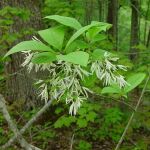| Common Name: |
Fringe Tree |
| Botanical Name: |
Chionanthus virginicus |
| Genus: |
Chionanthus |
| Family: |
Oleaceae |
| Native Location: |
Eastern N America |
| Cultivation: |
Well-drained soil in sun. Slow-growing in regions with cool summers. Flowers best in areas with long, hot summers. |
| Propagation: |
By seed sown in autumn, which requires stratification; by softwood cuttings in spring; by budding in summer. Germination may take up to 18 months. |
| Harvest: |
Bark is peeled from roots, which are removed as required, and dried for use in infusions, liquid extracts, and tinctures. |
| Height: |
8m (25ft) |
| Width: |
5m (15ft) |
| Hardiness: |
Z4-8 |
| Parts Used: |
Root bark |
| Properties: |
A bitter, tonic, alterative herb that stimulates the liver and gall bladder, and has both diuretic and laxative effects. |
| Medicinal Uses: |
Internally for jaundice, cirrhosis, chronic hepatitis, pancreatitis, gallstones, enlarged spleen, poor liver function, bilious headache, and migraine. Also as a tonic in chronic illness. Externally for cuts, bruises, and scrapes. |
| Bibliography: |
Encyclopedia of Herbs by Deni BrownCopyright © 1995, 2001 Dorling Kindersley Limited. pg. 167 |

